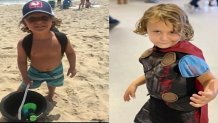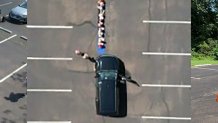It’s become almost a daily ritual for Jackie Foschi, walking through the garden located in the front yard of her home, named after her son Hudson.
"So, this is Hudson’s memorial garden. We transformed it,” the Virginia mother explains. "It's a time for my mind to be quiet. It's peaceful for me. That's why I did it."

For her, the spot is both beautiful and painful.
We've got the news you need to know to start your day. Sign up for the First & 4Most morning newsletter — delivered to your inbox daily. Sign up here.
“He loved picking flowers for me,” she said. "He loved like no one I knew. He made me laugh."
Even though he was only 4 years old, she called the little boy with the wavy blonde hair an old soul.
“He lived large,” she said. “He wasn't scared. I miss that personality."

On Jan. 8, 2019, a tragic accident happened where the garden now grows, originally the driveway.
Local
Washington, D.C., Maryland and Virginia local news, events and information
"He opened the gate, and I drove very slowly, like all the way up, and then he wasn’t there,” Foschi said. “I thought he was getting the mail. Your worst nightmare, he was under the car."
Hudson had been run over by the family SUV, his mom behind the wheel in total disbelief.
"I looked everywhere, first screaming. And then I saw him and I ripped him out from under the car. I was hoping he was joking, but he wasn’t. I never saw him," she said.
Her son died from his injuries, joining a growing list of children hurt or killed in this country because the driver didn't see them.
"You never feel like a good parent again. You never, you're never whole," Foschi said.
She said her family bought the large SUV thinking it would be safer but found she did have trouble sometimes seeing around it.
"I can’t tell you how many times I hit his bike,” she said. “They’re so tall and so big and you just can’t see it, you’re so high up in the air."
That's because as vehicles have gotten larger in this country, so have the blind zones according to Michael Brooks with the Center for Auto Safety.
"The fact is Americans are buying gigantic cars and that's part of the issue," he said.
Brooks said these larger blind zones have led to an increase in child fatalities and injuries around the country.
"These vehicles aren't getting smaller,” he said. “Their grills are getting higher, and I’ve even heard from drivers that they’re having a hard time seeing over these bigger hoods."
According to the latest data from the National Highway Traffic and Safety Administration, in 2015 there were 366 deaths and 15,000 injuries due to forward-moving vehicles, also called frontovers. All of them occurred on private property, like driveways.
"There's a large zone in front of the vehicle where you can't see something that's the height of a child, even the height of two or three children lined," said Brooks.

The News4 I-Team found that blind zone might be bigger than believed. A group of Virginia parents agreed to let their children participate in a demonstration to show the potential risk. In an empty parking lot, with the large SUV vehicle secured, the I-Team lined up one child after another in front as mom Christy Weeden sat behind the wheel. The I-Team asked her to tell us when she could see a child.
Slowly each child sat down in front of the other. One, two, three, four children.
"Nope, I don't see anything," Weeden said.
Five, six, seven, eight kids. She still couldn’t see them.
The I-Team then placed a ninth little boy in front.
"I don't see him at all," Weeden said.
It wasn't until the first child was moved to the 10th spot that she spotted anything.

"Just barely. Yep. I see. From his eyes up. That's it," Weeden said
The blind zone was a startling 16 feet.
That reality for moms and dads is a sickening feeling.
"Wow. That's a lot of kids. And they're not squished up either," Weeden said.
"It really shows the need for cameras on the front of cars or sensors, at the very least," said the father of another child.
By 2018 all American-made cars were required to have backup cameras. But there’s no law that says vehicles have to have front cameras. According to Brooks, few manufacturers include front cameras or 360-degree cameras as standard equipment. Most, he said, are normally found in luxury vehicles.
"I think the part that frustrates me most is seeing safety technology sold as a luxury when everyone should have it," he said.
After Hudson’s death, Foschi traded in her SUV for a smaller vehicle. She paid extra to have a front camera installed, technology she thinks could have saved her son’s life.
"The technology that’s out there and that I have in my new vehicle, he would still be here,” she said. “He would."
In the three years since he's been gone, most of the original driveway is covered.
"I miss everything. I couldn't even pick out one thing," she said.
Grass and flowers are now blooming where the family lost so much.
"We believe, and I hope, Hudson’s life can help save other people,” Foschi said. “I know he would have liked that."
Hudson's family created a scholarship in his name at the preschool he loved so much and helped build a new playground.
Experts said even those who have 360 cameras in their vehicles should always walk around the entire car before driving it. A spokesperson for the Alliance for Automotive Innovation, a trade association and lobby group that represents auto manufacturers, told the I-Team, “Safety is the auto industry’s top priority. Vehicles continue to get safer as automakers across the board test, develop and integrate new technologies that can save lives or prevent injuries. These innovations make the driving experience safer, but drivers are always urged to look first and check around their vehicles before operating them.”
Find additional vehicle safety information here.
Reported by Susan Hogan; produced by Rick Yarborough; shot by Steve Jones, Lance Ing and Carlos Olazagasti; and edited by Steve Jones.



